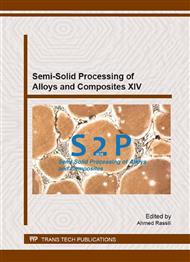p.81
p.88
p.94
p.100
p.107
p.113
p.119
p.126
p.133
Effect of Slurry Temperature Distribution on Semi-Solid Die Casting
Abstract:
Semi-solid alloy slurries with different temperature distributions have diverse flow patterns of the slurries during die casting filling process. This different flow patterns can lead to various degrees of front separation of the slurry metal from the die cavity during die filling process. This separation can result in air entrapment, which is one of the origins for gas porosities and blisters occurred during followed heat treatment. Therefore, in this paper, the effects of slurry temperature distribution on filling patterns during die casting process were investigated. Based on partial filling experiments, positive and negative gradient temperature distribution, together with two homogeneous conditions 575°C, 579°C were compared by computer simulation. The results indicate that the positive gradient temperature condition of 357.0 slurry is more suitable for the semi-solid die casting of the connector, and 7 °C temperature gradient in slurry is appropriate for good filling.
Info:
Periodical:
Pages:
107-112
Citation:
Online since:
September 2016
Authors:
Price:
Сopyright:
© 2016 Trans Tech Publications Ltd. All Rights Reserved
Share:
Citation:


